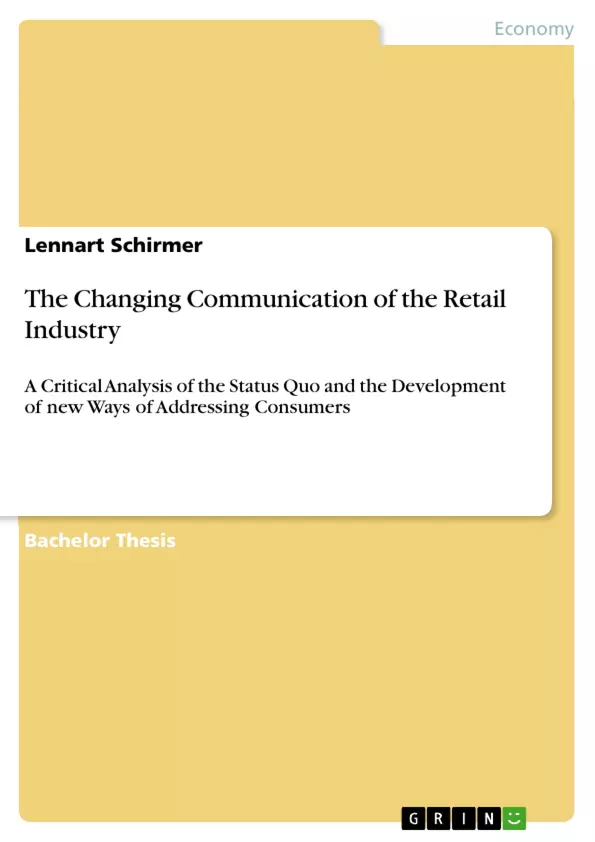Image advertising, the growing importance of online communication, the opportunities of Web 2.0, viral marketing as well as the need to integrate the different communication measures are just a few examples which point out the complexity and challenges for developing successful retail communication strategies. By discussing different case studies, the purpose of this paper is to provide evidence that that there is a actual change in retail communication and derive practical recommendations for retail companies.
Table of Contents
- A New Focus in Retail Communication
- Introduction
- Purpose of the Paper
- Research Objective
- Methodology
- Fundamentals of Communication and the German Retail Industry
- Fundamentals of Communication
- Definition of Communication and Communication Objectives
- Classification and Analysis of Communication Instruments
- Classification of Communication Instruments
- Media Advertising
- Offline and Online Direct Marketing Including Mobile Marketing
- Online Marketing and User-Generated content
- The Retail Industry in Germany
- Definition of Retailing
- Analysis of the German Retail Market
- Structure of the German Retail Market
- Retail Competition in Germany
- Trends in Consumer Behavior
- Challenges in Communication and Implications for Retailers
- Special Characteristics and Problems of Retail Communication
- Retail Communication in Comparison to Communication of Manufacturers
- Positioning and Retail Branding as Challenges for Retail Communication
- The Role of Communication in Retail Marketing
- Identification of Future Challenges and Implications for Retail Communication
- Economic Challenges
- Socio-Cultural Challenges
- Technological Challenges
- Summary: Implications for Retail Communication
- Analysis of Practical Examples of Communication Strategies and Instruments of the Retail Industry
- From Price Communication to Image and Assortment Communication
- Evaluation of Flyers and Leaflets as an Example of Price Communication
- Image Communication and Retail Branding Through Media Advertising
- Private Labels as an Example of Assortment Communication
- Individualization and Customer Retention Through via Direct Communication
- Online and Offline Direct Communication
- Customer Cards and Bonus Programs
- Customer Magazines
- From Classical Communication to New Media Communication
- Weblogs and Online Communities as an Example of Web 2.0 Opportunities
- Viral Marketing
- Integration of User-Generated Content for Communication
- Marketing Strategies for 3D Internet Using the Example of "Second Life"
- Recommendations for Food Retail Communication
Objectives and Key Themes
This thesis aims to critically analyze the changing communication landscape in the retail industry. It explores the evolution of communication strategies from traditional price-focused approaches to contemporary methods that prioritize branding, customer engagement, and new media integration. The research delves into the specific challenges and opportunities facing retailers in a dynamic market, considering economic, socio-cultural, and technological factors.
- The shift from price-driven communication to a more holistic approach emphasizing branding and customer experience.
- The growing influence of online communication and the potential of Web 2.0 tools for retailers.
- The importance of understanding and responding to evolving consumer behaviors in a digital age.
- The need for retailers to adapt their communication strategies to address various economic, socio-cultural, and technological challenges.
- The critical role of communication in building a strong brand identity and achieving sustainable customer relationships.
Chapter Summaries
- A New Focus in Retail Communication: This chapter introduces the thesis by highlighting the growing prominence of retail brands in advertising and the need for retailers to adapt their communication strategies to a changing market. It explores the shift from traditional price-focused approaches to a more holistic perspective that encompasses branding, customer engagement, and new media integration.
- Fundamentals of Communication and the German Retail Industry: This chapter provides a comprehensive overview of communication theory, including definitions, objectives, and classifications of communication instruments. It then examines the specific context of the German retail market, analyzing its structure, competition, and evolving consumer behaviors.
- Challenges in Communication and Implications for Retailers: This chapter delves into the specific challenges and opportunities facing retailers in a dynamic market, focusing on the unique characteristics of retail communication compared to that of manufacturers. It identifies and analyzes economic, socio-cultural, and technological factors that influence communication strategies, emphasizing the need for retailers to adapt to these evolving trends.
- Analysis of Practical Examples of Communication Strategies and Instruments of the Retail Industry: This chapter presents a range of case studies illustrating various communication strategies and instruments employed by the retail industry. It examines practical examples of price communication, image and assortment communication, direct communication, and new media communication, highlighting successful approaches and exploring their implications for retail marketing.
- Recommendations for Food Retail Communication: This chapter provides specific recommendations for food retailers based on the insights gained from the analysis of communication strategies and instruments. It offers practical advice on how food retailers can leverage the principles of effective communication to achieve their marketing objectives and build strong customer relationships.
Keywords
This work focuses on the evolving communication landscape of the retail industry, exploring key concepts such as retail communication strategies, branding, customer engagement, new media, Web 2.0, viral marketing, and user-generated content. It examines the challenges and opportunities presented by the German retail market, encompassing topics like price communication, image communication, direct marketing, and online communication.
- Quote paper
- Lennart Schirmer (Author), 2007, The Changing Communication of the Retail Industry, Munich, GRIN Verlag, https://www.grin.com/document/75806



